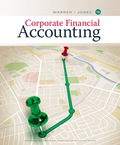
Corporate Financial Accounting
15th Edition
ISBN: 9781337670517
Author: WARREN
Publisher: Cengage
expand_more
expand_more
format_list_bulleted
Concept explainers
Question
Chapter D, Problem D.5EX
(a)
To determine
Bond investment: Bond investments are debt securities which pay a fixed interest revenue to the investor.
Debit and credit rules:
- Debit an increase in asset account, increase in expense account, decrease in liability account, and decrease in
stockholders’ equity accounts. - Credit decrease in asset account, increase in revenue account, increase in liability account, and increase in stockholders’ equity accounts.
To journalize: The bond investment transaction for purchase of $150,000 8% bonds of Corporation J at face value, on October 1, 20Y2
(b)
To determine
To journalize: The bond investment transaction for accrued interest, on December 31, 201Y2
(c)
To determine
To journalize: The bond investment transaction for accrued interest, on December 31, 201Y2
(d)
To determine
To journalize: The bond investment transaction for $50,000 bonds sold at 102%, on April 1, 20Y3
Expert Solution & Answer
Want to see the full answer?
Check out a sample textbook solution
Students have asked these similar questions
Question 5: Acid-Test RatioA company has the following data:
Cash: $50,000Accounts Receivable: $30,000Inventory: $60,000Current Liabilities: $70,000a) What is the company’s acid-test ratio?b) Is the company in a strong liquidity position based on this ratio? Expl
D
E
F
G
H
RELATIVE CELL REFERENCES
J
K
L
M
N
A
B
1234567
Growth Rate
(Expected)
Year 0
Year 1
Formulas
4 Investment A
12%
$2,200
#N/A
5 Investment B
6 Investment C
1%
$2,200
3%
$2,200
#N/A
#N/A
Year 5
Year 6
Year 7
Year 8
Year 9
Year 10
8 "Take each value in column C and multiply it by its adjacent growth rate in column B (which is 1 plus the percentage expected growth)."
9
10
ABSOLUTE CELL REFERENCES
11
12
Growth Rate
(Expected)
13 Investment A
12%
Year 0
$2,200
Year 1
Year 2
Year 3
Year 4
14
15 Formulas
#N/A
#N/A
#N/A
#N/A
#N/A
16
#N/A
#N/A
#N/A
#N/A
17 "Start in column D, then move across allowing the column to change, and multiply the preceding value by its FIXED growth rate in cell $B$13 (which is 1 plus the percentage expected growth) to get the current value."
#N/A
18
19
FIXED COLUMN / RELATIVE ROW CELL REFERENCES
20
Growth Rate
21
(Expected)
Year 0
Year 1
Year 2
Year 3
Year 4
Year 5
Year 6
Year 7
Year 8
Year 9
Year 10
22 Investment A
23 Investment B
24 Investment C
12%
1%
3%…
Can you provide the accurate answer to this financial accounting question using correct methods?
Chapter D Solutions
Corporate Financial Accounting
Ch. D - Prob. D.1EXCh. D - Entries for stock investments, dividends, and sale...Ch. D - Bond investment transactions Starks Products uses...Ch. D - Prob. D.4EXCh. D - Prob. D.5EXCh. D - Prob. D.6EXCh. D - Prob. D.7EXCh. D - Valuing trading securities at fair value On...Ch. D - Fair value journal entries, trading investments...Ch. D - Fair value journal entries, trading investments...
Knowledge Booster
Learn more about
Need a deep-dive on the concept behind this application? Look no further. Learn more about this topic, accounting and related others by exploring similar questions and additional content below.Similar questions
- Total unit cost for part Y isarrow_forwardQuestion 5: Acid-Test RatioA company has the following data: Cash: $50,000Accounts Receivable: $30,000Inventory: $60,000Current Liabilities: $70,000a) What is the company’s acid-test ratio?b) Is the company in a strong liquidity position based on this ratio? Need helparrow_forwardI need help finding the accurate solution to this general accounting problem with valid methods.arrow_forward
- Provide correct answer this accounting questionarrow_forwardRivera Corp. reported the following balances at the end of the year: Credit Sales: $320,000, Accounts Receivable: $85,000, Allowance for Uncollectible Accounts before adjustment: $1,500 debit. Rivera Corp. estimates that 6.5% of the credit sales are uncollectible. After the year-end adjustment, what is the Net Realizable Value of Accounts Receivable?arrow_forwardI want answerarrow_forward
- Financial Accountingarrow_forwardQuestion 4: Depreciation (Straight-Line Method)A company purchases machinery for $50,000. The estimated salvage value is $5,000, and the useful life is 10 years. a) Calculate the annual depreciation expense.b) What will the book value of the machinery be after 4 years? explanation please.arrow_forwardQuestion 4: Depreciation (Straight-Line Method)A company purchases machinery for $50,000. The estimated salvage value is $5,000, and the useful life is 10 years. a) Calculate the annual depreciation expense.b) What will the book value of the machinery be after 4 years? Explain.arrow_forward
arrow_back_ios
SEE MORE QUESTIONS
arrow_forward_ios
Recommended textbooks for you
 Financial AccountingAccountingISBN:9781305088436Author:Carl Warren, Jim Reeve, Jonathan DuchacPublisher:Cengage Learning
Financial AccountingAccountingISBN:9781305088436Author:Carl Warren, Jim Reeve, Jonathan DuchacPublisher:Cengage Learning Intermediate Accounting: Reporting And AnalysisAccountingISBN:9781337788281Author:James M. Wahlen, Jefferson P. Jones, Donald PagachPublisher:Cengage Learning
Intermediate Accounting: Reporting And AnalysisAccountingISBN:9781337788281Author:James M. Wahlen, Jefferson P. Jones, Donald PagachPublisher:Cengage Learning College Accounting, Chapters 1-27AccountingISBN:9781337794756Author:HEINTZ, James A.Publisher:Cengage Learning,
College Accounting, Chapters 1-27AccountingISBN:9781337794756Author:HEINTZ, James A.Publisher:Cengage Learning,

Financial Accounting
Accounting
ISBN:9781305088436
Author:Carl Warren, Jim Reeve, Jonathan Duchac
Publisher:Cengage Learning

Intermediate Accounting: Reporting And Analysis
Accounting
ISBN:9781337788281
Author:James M. Wahlen, Jefferson P. Jones, Donald Pagach
Publisher:Cengage Learning


College Accounting, Chapters 1-27
Accounting
ISBN:9781337794756
Author:HEINTZ, James A.
Publisher:Cengage Learning,